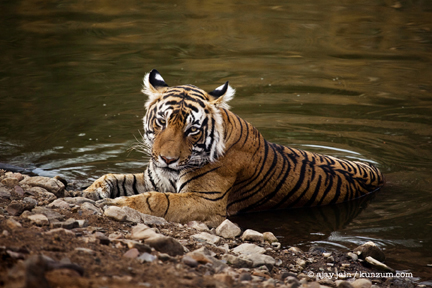Ajay Jain

The baby tiger cub, a close-up
Would you ride in an open Gypsy in temperatures exceeding 50 degrees Celsius? With the sun threatening to burn everything in sight, and the desert sand piercing your skin like countless needles? You would, if you were on the trail of the tiger in the Ranthambhore
National Park in Rajasthan. One of the few forests in India where tigers still prowl, you can be almost assured of a sighting – but only if you venture out when summer is at its harshest. This is when water sources dry up, and animals come out in the open
to water holes. And the dry vegetation makes camouflaging difficult. The roll of dice can still go against you, or you may be lucky like me – with seven sightings over a single weekend.

T17 on the prowl after a failed hunt
The opening act turned out to be the best – and a rare one at that. I spotted a male tiger, named T2 by the creativity deficient authorities, sitting by a water hole and a recently hunted langoor monkey lying in state three feet away.
I was not more than ten feet away myself. T2 was waiting patiently, either for a guest or for the dinner bell to sound, when something in the water disturbed him. He slowly turned his head, looked for a few moments through the surface and then it was Pow-Wow
in a flash. A poor turtle had floated in, and was probably the starter (or was it dessert) that T2 was waiting for. For the next many seconds, all one could see was frantic splashing as the turtle put up a brave fight. Before long, it was all tranquil again.
The big cat had expectedly won, but it would be a while before he could carve the flesh out from under the hard shell. Witnessing a tiger in action live beats the most spectacular of hunts you would see on National Geographic.

T2, waiting to eat the langoor he had hunted a few minutes before

T2 trying to eat the soft underbelly of the turtle under its hard outer shell
It would be morally illegal to have a perfect trip, but I almost did. The following morning I encountered another male, T17 (these tigers will make someone pay for these disgraceful names), looking hungrily at a herd of deer around a small lake. He weighed
his options, made some calculations, and was off like a shot – a yellowed silhouette of a torpedo racing through tall grasses at his target. But it turned out to be a dud. The chap could have done with some heat sensing technology, like the Scuds, to home
into his prey. Before long, he wandered aimlessly and crossed in front of my Gypsy – a scrawny fellow looking malnourished. Needs to be a better hunter I guess. He also had what looked like a dog strap around his neck. T17 has a tendency to wander outside
the reserve area – the installed tracker helps pull him by the ears right back where he belongs. True to his reputation, he crossed the limits the same evening. I was driving around in my own car around the periphery of the forest when he ambled across on
the road. Still looking for food. He finally settled for a stinking carcass in a baoli (stepwell) – certainly not a meal fit for a royal species. But times can be hard for anyone.

The baby tiger cub lounging in a water pool
The most entertaining was a tiger cub – actually more like an overgrown baby. At three years, he looked much sturdier than the adult T17. And he still had to learn to hunt. I guess being fed by the mother does have its advantages. Still to be christened, let’s
call him Baby T (where is my creativity now), he was lounging in the shade for hours at another water hole, probably waiting for his mother and siblings. A bunch of langoors must have known his teeth and claws carry no firepower yet – and took it upon themselves
to tease him. Perched on a long branch right above his temporary abode, they danced and made noises at Baby T incessantly for hours. But our boy made sure he sent a message across – by looking back at them with snarling expressions as if to say, “It is just
a matter of time before you guys will be on my plate. So stop monkeying around.” Despite waiting forever, the rest of the family failed to make an appearance for our entertainment.
Ranthambhore: Travel Tips
• Booking for safaris can be made online at
http://www.rajasthanwildlife.in – always a good idea to do so in advance during peak seasons. There is an option of going in a canter bus (seating 20) or in a Gypsy (for 5); the latter is the better option.
• You can drive to Ranthambhore from Delhi – it is 400 kms (250 miles) and takes 6-7 hours. Many trains also go to Sawai Madhopur, the town adjoining the park.
• For best sightings, go from April – June. Tourist traffic will also be low, and hotels offer great discounts.
• Ranthambhore is full of properties for all budgets – starting with the pricey Oberoi Vanyavilas down to rooms costing no more than a few hundred Rupees a night. Food is best had at the places you are staying – unless you want to venture into town where the
options are not really much to write home about.
• The park is usually closed from July 1 – September 30.